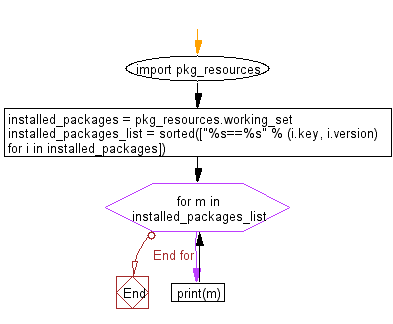Python: Get a list of locally installed Python modules
Locally Installed Modules
Write a Python program to get a list of locally installed Python modules.
Sample Solution:
Python Code:
# Import the 'pkg_resources' module for working with Python packages.
import pkg_resources
# Get the list of installed packages using 'pkg_resources.working_set'.
installed_packages = pkg_resources.working_set
# Create a sorted list of strings representing installed packages and their versions.
installed_packages_list = sorted(["%s==%s" % (i.key, i.version) for i in installed_packages])
# Print each package and its version in the sorted list.
for m in installed_packages_list:
print(m)
Sample Output:
asn1crypto==0.24.0 beautifulsoup4==4.5.1 biopython==1.71 bkcharts==0.2 bokeh==0.12.6 cairocffi==0.9.0 cairosvg==2.0.3 certifi==2018.11.29 cffi==1.11.5 chardet==3.0.4 cryptography==2.4.2 cssselect==1.0.1 cvxopt==1.2.2 cycler==0.10.0 decorator==4.3.0 ete3==3.1.1 exifread==2.1.2 genshi==0.7 html5lib==0.999 idna==2.8 jinja2==2.10 jsonschema==2.6.0 kiwisolver==1.0.1 lxml==3.7.0 markupsafe==1.1.0 marshmallow-polyfield==3.2 marshmallow==2.18.0 matplotlib==2.2.3 mpmath==1.1.0 mysql-connector-python==8.0.12 names==0.3.0 networkx==2.2 nose==1.3.7 ntlm-auth==1.2.0 numexpr==2.4.3 numpy==1.15.4 oauthlib==3.0.0 pandas==0.23.4 patsy==0.4.1 pillow==5.4.1 pip==18.0 ply==3.11 pronouncing==0.1.5 protobuf==3.6.1 psutil==5.4.8 pycep-correios==2.3.1 pycolors==0.1.2 pycparser==2.19 pycurl==7.43.0 pygal-maps-ch==1.0.1 pygal-maps-fr==1.1.0 pygal-maps-world==1.0.2 pygal==2.3.1 pygobject==3.20.0 pyparsing==2.3.1 python-apt==1.1.0b1+ubuntu0.16.4.1 python-dateutil==2.7.5 pytz==2018.9 pyyaml==3.13 qiskit-aer==0.1.0 qiskit-aqua==0.4.1 qiskit-terra==0.7.0 qiskit==0.7.0 requests-ntlm==1.1.0 requests-oauthlib==0.8.0 requests==2.21.0 scikit-learn==0.20.0 scipy==1.2.0 seaborn==0.8.1 setuptools==40.6.3 six==1.12.0 statsmodels==0.8.0 sympy==1.3 tables==3.2.2 tinycss==0.4 tornado==5.1.1 urllib3==1.24.1 wheel==0.29.0
Explanation:
The above Python code uses the "pkg_resources" module to retrieve information about installed Python packages. It then creates a sorted list of strings representing each installed package along with its version and prints this information. The result is a list of installed packages and their versions.
Flowchart:

For more Practice: Solve these Related Problems:
- Write a Python program to check which of the locally installed modules have updates available.
- Write a Python program to list all installed Python modules along with their respective version numbers.
- Write a Python program to verify whether a specified list of modules are installed on the local system.
- Write a Python program to generate a dependency tree for a selected locally installed Python package.
Go to:
Previous: Write a Python program to get the top stories from Google news.
Next: Write a Python program to display some information about the OS where the script is running.
Python Code Editor :
Have another way to solve this solution? Contribute your code (and comments) through Disqus.
What is the difficulty level of this exercise?
Test your Programming skills with w3resource's quiz.
